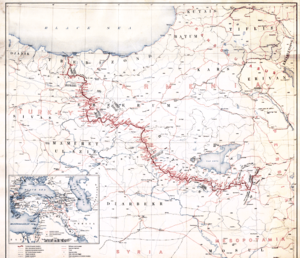- Western Armenia
-
This article is about the historical subregion in Eurasia. For the geographical region, see Armenian Highland. For the provisional government of 1915–18, see Administration for Western Armenia. For the name given to the Armenian part of the Byzantine Empire, see Byzantine Armenia.
 The Armenian population of the eastern regions of the Ottoman Empire in 1870s, before the systematic killings of Armenians. (in Armenian)
The Armenian population of the eastern regions of the Ottoman Empire in 1870s, before the systematic killings of Armenians. (in Armenian)
Western Armenia (for other name see below) is a term, prmarily used by Armenians, to refer to Armenian-inhabited areas of the Armenian Highland that were part of the Ottoman Empire and now are part of the Republic of Turkey.
After the Hamidian Massacres of 1894-1896 and the Armenian Genocide (1915-1923) the indigenous Armenian population was either massacred, escaped to Russia or deported to the Syrian deserts. Currently, mostly Kurds and Turks live in that area, with minorities being Azerbaijanis, Laz people and Hamshenis.
Contents
Names
- In English
- Turkish Armenia is an archaic term used until 1920s
- Ottoman Armenia is an archaic term used until 1920s
- In Armenian
- Արեւմտեան Հայաստան (Arevmdean Hayasdan) in Western Armenian meaning "Western Armenia"
- Արևմտյան Հայաստան (Arevmtyan Hayastan) Eastern Armenian meaning "Western Armenia"
- Տաճկահայաստան (Tačkahayastan / Daǰkahayasdan) is an archaic term used until 1920s meaning "Turkish Armenian"
- Թրքահայաստան (Trkahayastan) is an archaic term meaning "Turkish Armenia"
History
 The Six Armenian vilayets (provinces) of the Ottoman Empire were defined as Western Armenia.
The Six Armenian vilayets (provinces) of the Ottoman Empire were defined as Western Armenia.
Ottoman conquest
After Turkish-Persian wars of 1602-1639 Western Armenia became part of Ottoman Empire.[1] Since Russo-Turkish War, 1828-1829 that term is referred to the Armenian-populated historical regions of the Ottoman Empire that remained under Ottoman rule after the eastern part was ceded to the Russian Empire.
Western (Ottoman) Armenia was composed of six vilayets (vilâyat-ı sitte), the vilayets of Erzurum, Van, Bitlis, Diyarbekir, Kharput, and Sivas.[2]
World War I
See also: Armenian Genocide and Caucasus Campaign Armenian Genocide: map of massacre locations and deportation and extermination centers
Armenian Genocide: map of massacre locations and deportation and extermination centers
During the collapse of Ottoman Empire Western Armenia remained under Turkish rule, and in 1894–96 and 1915 the Ottoman Empire perpetrated systematic massacres and forced deportations of Armenians[3] resulting in the Armenian Genocide.
During the Caucasus Campaign of the World War I, Russian Empire occupied most of the Armenian-populated regions of the Ottoman Empire, where a temporary provincial government was established in 1915–1918.
Current situation
 The modern concept of the United Armenia as used by the Armenian Revolutionary Federation (Dashnaktsutyun).
The modern concept of the United Armenia as used by the Armenian Revolutionary Federation (Dashnaktsutyun).
The fate of Western Armenia — commonly referred to as "The Armenian Question" — is considered as a key issue in the modern history of the Armenian people.[4] The first and second congresses of Western Armenians took place in Yerevan in 1917 and 1919. Since 2000, an organizing committee of congress of heirs of Western Armenians who survived the Armenian Genocide is active in diasporan communities.[5]
Currently, the Republic of Armenia doesn't have any territorial claims to the Republic of Turkey, although, some political parties such as the Armenian Revolutionary Federation, the largets Armenian party in the diaspora, claim the area given to the Republic of Armenia (1918-1920) by US President Woodrow Wilson's arbitral award in 1920, also known as Wilsonian Armenia.
Demographics
Main articles: Ottoman Armenian population and Six vilayets#Demographics The western border of the Republic of Armenia as drawn by US President Woodrow Wilson's arbitral award in 1920. The territory is also know as Wilsonian Armenia.
The western border of the Republic of Armenia as drawn by US President Woodrow Wilson's arbitral award in 1920. The territory is also know as Wilsonian Armenia.
See also
- History of Armenia
- Geography of Armenia
- Armenian Highland
- Armenians in the Ottoman Empire
- Ottoman Armenian population
References
- ^ Феодальный строй, Great Soviet Encyclopedia (Russian)
- ^ Armenia
- ^ Britannica Online: Armenia
- ^ Arman J. Kirakossian, British Diplomacy and the Armenian Question, from the 1830s to 1914
- ^ WESTERN ARMENIANS ARE PREPARING, A1plus, 16 November, 2007
Further reading
- Arman J. Kirakosian, "English Policy towards Western Armenia and Public Opinion in Great Britain (1890-1900)", Yerevan, 1981, 26 p. (in Armenian and Russian).
External links
Categories:- Western Armenia
- History of Armenia
- Medieval Anatolia by region
- Ottoman Anatolia
Wikimedia Foundation. 2010.


